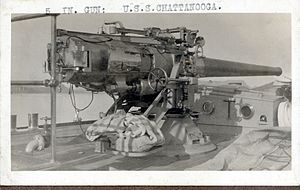 Chattanooga, 5"/50 caliber deck gun, probably port side forward. | |
| Type |
|
| Place of origin | United States |
| Service history | |
| In service | 1904 |
| Used by | |
| Wars | |
| Production history | |
| Designer | Bureau of Ordnance |
| Designed | 1900 |
| Manufacturer | U.S. Naval Gun Factory |
| No. built |
|
| Variants | Mark 5 Mods 0–3, Mark 6 Mods 0–2 |
| Specifications | |
| Mass |
|
| Length | Marks 5 and 6: 255.65 in (6,494 mm) |
| Barrel length | Marks 5 and 6: 250 in (6,400 mm) bore (50 calibers) |
| Shell |
|
| Caliber | 5 in (127 mm) |
| Elevation |
|
| Traverse | −150° to +150° |
| Rate of fire | 6–8 rounds per minute |
| Muzzle velocity |
|
| Maximum firing range | 19,000 yd (17,000 m) at 25.3° elevation |
The 5"/50 caliber gun (spoken "five-inch-fifty-caliber") was the first long barrel 5-inch (127 mm) gun of the United States Navy and was used in the secondary batteries of the early Delaware-class dreadnought battleships, various protected cruisers, and scout cruisers. They were also refitted in the secondary batteries of the armored cruiser New York and the New Orleans-class protected cruisers. They were later used on cargo ships, store ships and unclassified auxiliaries during World War II as well as in emergency coastal defense batteries.[1]
Design
[edit]The Mark 5, Nos. 200 – 286, was a 50 caliber naval gun of a simplified construction by combining the breech piece along with the chase hoop into one long tube that was shrunk on from the muzzle. Mod 1 was a Mod 0 gun that was relined with a conical nickel-steel liner and an additional gun-steel chase hoop that extended to the muzzle that was secured by a nickel-steel locking ring. Mod 2, gun No. 280, had a slightly different liner with Mod 3, gun No. 245, was a Mod 0 gun with its gun-steel tube replaced with a nickel-steel tube with a gun-steel chase hoop added that extended all the way to the muzzle. The Mod 3 gun had a longer chase hoop and shorter jacket compare to Mods 1 and 2.[1][2]
The Mark 6, gun Nos. 293 – 356, was the bag-ammunition equivalent to the Mark 5 gun. Mod 0, Nos. 323 – 356, had a single jacket constructed of nickel-steel, that replaced the jacket, chase hoop and locking ring of the Mark 5. Mod 1, Nos. 293 – 306 and 308, was built of gun-steel with a chamber of a different design with some external differences to fit it onto different mountings. The Mod 2, Nos. 307 and 309 – 322, had the same chamber as the Mod 0 but was otherwise almost identical to the Mod 1.[1][2]
Naval Service
[edit]| Ship | Gun Installed | Gun Mount |
|---|---|---|
| USS Delaware (BB-28) | Mark 6 Mod 0: 14 × 5"/50 caliber (Nos. 343–356) | Mark 9 and 12 |
| USS North Dakota (BB-29) | Mark 6 Mod 0: 14 × 5"/50 caliber (Nos. 329–342) | Mark 9 and 12 |
| USS New York (ACR-2) | Mark 6 Mod 1: 10 × 5"/50 caliber (Nos. 295–304) (1907 refit) | Unknown |
| USS Denver (C-14) | Mark 5: 10 × 5"/50 caliber | Unknown |
| USS Des Moines (C-15) | Mark 5: 10 × 5"/50 caliber | Unknown |
| USS Chattanooga (C-16) | Mark 5: 10 × 5"/50 caliber | Unknown |
| USS Galveston (C-17) | Mark 5: 10 × 5"/50 caliber | Unknown |
| USS Tacoma (C-18) | Mark 5: 10 × 5"/50 caliber | Unknown |
| USS Cleveland (C-19) | Mark 5: 10 × 5"/50 caliber | Unknown |
| USS Chester (CS-1) | Mark 6 Mod 0: 2 × 5"/50 caliber (Nos. 323–324) | Unknown |
| USS Birmingham (CS-2) | Mark 6 Mod 0: 2 × 5"/50 caliber (Nos. 325–326) | Unknown |
| USS Salem (CS-3) | Mark 6 Mod 0: 2 × 5"/50 caliber (Nos. 327–328) | Unknown |
| USS New Orleans (CL-22) | Mark 5: 10 × 5"/50 caliber (1904 and 1907 refits) | Unknown |
| USS Albany (CL-23) | Mark 5: 10 × 5"/50 caliber (1904 and 1907 refits) | Unknown |
The 5-inch/50 caliber gun was also used on cargo ships, store ships and unclassified auxiliaries during World War II.[1]
Notes
[edit]- ^ a b Friedman 2011, p. 184–185.
References
[edit]- Friedman, Norman (2011). Naval Weapons of World War One. Seaforth Publishing. ISBN 978-1-84832-100-7.
- "United States of America 5"/50 (12.7 cm) Mark 5 and Mark 6". Navweaps. 12 February 2008. Retrieved 20 October 2016.
Well, that’s interesting to know that Psilotum nudum are known as whisk ferns. Psilotum nudum is the commoner species of the two. While the P. flaccidum is a rare species and is found in the tropical islands. Both the species are usually epiphytic in habit and grow upon tree ferns. These species may also be terrestrial and grow in humus or in the crevices of the rocks.
View the detailed Guide of Psilotum nudum: Detailed Study Of Psilotum Nudum (Whisk Fern), Classification, Anatomy, Reproduction